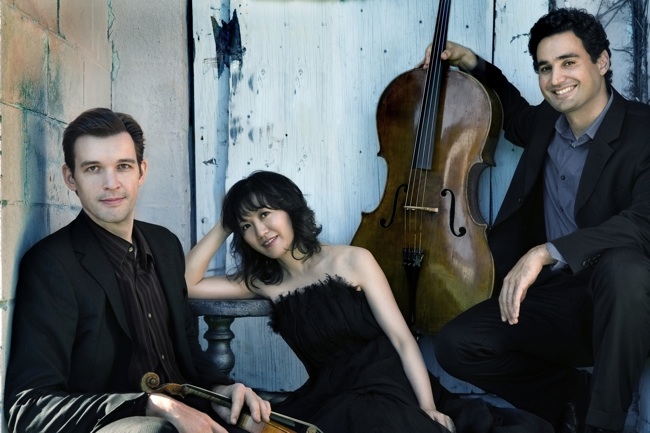Of dotted notes and civilized despair…
Last Sunday the Horszowski Trio made their first appearance at Kohl Mansion, and judging by the response, they would be warmly welcomed back. These three musicians have a long and slightly tangled history, and two of them have already appeared at Kohl Mansion with other top groups.

Rieko Aizawa played the piano with a wealth of colors and moods, from daisy-fresh to slate and steel. Violinist Jesse Mills had a sweet electricity in his top register and thick feeling on his lower strings, and cellist Raman Ramakrishnan delivered both poise and gravitas, with high runs, yearning and slippery, and low resonances wrapped in earth.
And equally impressive to their individual sounds was their wonderful accord. Mills and Ramakrishnan have played together since childhood (both musically and otherwise!), and Mills and Aizawa have toured as a piano and violin duo for years. Based in New York, the three are now all on the faculty of New York’s Columbia University and Cambridge’s Longy School of Music.
They led us into their world gently, beginning with Camille Saint-Saens’ Trio No. 1 in F Major. Written in 1864, this was the epitome of civilized music – loving, sprightly and fit for drawing rooms (does anyone draw in those?). But then came fickle piano notes and sudden luscious accords, and the conversation became broader.
And then in the slow Andante Aizawa gave us trickling arpeggios of fat, sun-filled notes. The strings were slow and lilting, and traded lovely iambic verses back and forth. This was the first appearance of these dotted notes on the program, and it was meant to be visceral and light-hearted. That is to say, wondrously French.
… and more dotted notes and hope.
Ramakrishnan took the mike to introduce us to the next piece, For Daniel by Joan Tower.
“We worked with Joan Tower when preparing this piece. She’s lively and funny, but this piece shows a different side. Daniel, her nephew, suffered from a lung disease. Tower didn’t have children and she was close to her nephew… You are going to hear the breath and the struggle to breathe from the beginning of this piece. Daniel didn’t live to hear the premiere, and there is a lot of rage, but later there is also joy of life and a feeling of acceptance.”
Unison strings suggested long inhales and sharp exhales, bows travelling to their tips and biting into the strings. They separated into two lines, and their struggles overlapped into a sudden and disturbing music. Piano chords, first meditative, then random and trickling, framed a discourse on chance and life in an impersonal universe.
And then, in the middle, those long-short rales of breath became a flurry of dotted notes – not French and teasing, like Saint-Saens’, but gasping explosions, uneven rhythms cutting against the grain of life.
A slower movement followed, with coloristic and spectral piano chords and string harmonics, and then the cello transformed its solo into a lullaby, a shockingly intimate moment. This was a roller coaster of a work, with huge piano excursions by turns angry and reverential.
After intermission, they switched gears to Robert Schumann’s Trio No. 1 in D minor, a famous work of sweeping German Romanticism. From thirsting to fevered, this was a longing paean to Art and Love amid whispers of Lost Innocence.
And then there were those dotted iambs! But this time they were passionate cries in a nineteenth century storm. How strange that one device could be so supple.
In the Langsam there was slow beauty and a piquantly modern texture of high piano curlicues and skating cello harmonics. It was a riveting use, and Tower’s slow movement could have been Schumann’s modern relative. And then a last parallel, where all three works turned from minor to a slow simple statement in the major, just after their apex. Like those dotted notes, that shift meant very different things: Saint-Saens’ shy “oui,” Tower’s lullaby to the dying, and Schumann’s embrace of hope.
And what comes after hope? For Schumann’s Trio it was triumph (and for Schumann, eventual madness). For Daniel, I would like to believe it was rest.
Rest in peace, Daniel.
—Adam Broner
Photo of the Horszowski Trio, from left: violinist Jesse Mills, pianist Rieko Aizawa, and cellist Raman Ramakrishnan; photo by Lisa-Marie Mazzucco.
